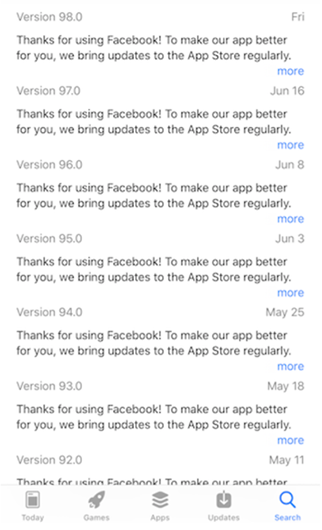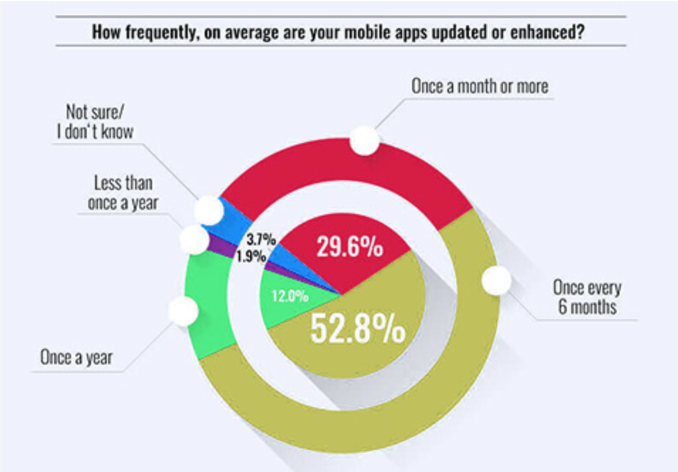5 Reasons Businesses Should Update Their Mobile App Regularly

5 Reasons Businesses Should Update Their Mobile App Regularly
Updates are critical to maintaining your app and introducing new features that increase user engagement. This article discusses how often a business should update its app and provides some best practices for app updates.
Your business took the leap and made the investment to develop and launch a mobile app. Congratulations—now all your work is done and you can sit back, relax, and let the app do its work to gain you customers, market share, and insights. Right?
Wrong. The work has just begun, actually. After all, a mobile app is only as good as its latest version, which means you need consistent updates to keep your app “fresh” and relevant.
But how often should you update your app, and what are the main points to consider when you upgrade? This article will provide some guidance regarding upgrade frequency and best practices.
- Update Frequency: What Is Your Magic Number?
- 5 Reasons Developers Should Update Their Apps Regularly:
- Keep Your Users Happy
- Stay Ahead of Bugs
- Make “Hardly Noticeable” Tweaks to Your UX
- Keep Up With Technology
- Stay Relevant
Update Frequency: What Is Your “Magic Number?”
Once a business launches an app, the focus should shift to updating. The development cycle is recursive and continuous.

According to a recent survey by The Manifest, more than a third (38%) of companies update their app every month, while almost half (45%) update their app every 2-6 months. But which of those schedules are correct? How often is enough?
The short answer is, “It depends.” Truthfully, there is no “magic number” when it comes to updating your app.
Updates are necessary to maintain usability and engage users. But the update frequency should depend on several different factors, including your business’s goals and the app’s functionality.
Some apps, like Facebook, will update like clockwork on a weekly schedule.

That is not unusual, though. Most successful apps release 1-4 updates a month and, since they are popular with users, those companies can get away with that kind of rigorous update schedule.
But not all businesses have the capability to update that frequently, and updating just for the sake of putting out a new version is a waste of time, money, and effort. Instead, 3 main factors should dictate your app update frequency. These are:
- Feedback
- Data
- Team size
Budget can also play a large part in app update frequency.
On average, a business can expect to spend anywhere from 10 to 30% of the original development cost on updates. Many experts put the number at 20%.
Since every app’s requirements are slightly different, it’s best to get expert help on what to expect in terms of update costs.
Updates are often worth the cost, though. Below are 5 key reasons you should be updating your app regularly.
Reason #1: Keep Your Users Happy
No matter how much time and effort you invest in app testing and focus groups, real app users will give you the most valuable feedback about ways to improve your app.
If your app does well, you’re going to get feedback. Customers are going to tell you what they like and what they don’t like. And, if you’re smart, you’ll listen to them!
There’s always room for improvement, so it’s important to seek out such feedback. There are a number of tools your business can use to solicit the opinions of your app users, including:
By collecting the feedback and implementing the changes your users ask for, you will show that you care about quality. This will increase engagement and make for more loyal users.
It can be a good practice to plan for major quarterly updates in response to analytics and user feedback. However, it should be noted that some companies may opt for more frequent updates, particularly in cases where you’re taking a phased approach to your app’s development.
Reason #2: Stay Ahead of Bugs
Typically, user feedback will point out any bugs in your mobile app. Sorry to say, but no matter how thoroughly you test your app, you will likely still find bugs in the system.
All apps are buggy in some way. There are simply too many variables involved to avoid all issues. What is most important to users is how quickly your developers can address the problems.
If you’re seen as a company that irons out app issues quickly, you’ll retain users. If you ignore the problems and simply let your app rot, users will abandon your app in droves. Nobody will support an app if the company behind it is seen as not caring.
The good thing about bugs is that most can be found and fixed with tools that are readily available. Invest in an automated solution, such as Crashlytics, to research, analyze, find, and fix bugs through real-time crash reporting, analysis, and issue aggregation.
Reason #3: Make “Hardly Noticeable” Tweaks to Your UX
Just like a singer on “The Voice,” you need to change your app’s “tune” and address the judges’ (users’) feedback just enough in order to stay fresh and relevant. However, those changes don’t need to be so large that the users even notice.
As opposed to major bugs, which can be critical and prevent users from using the application, these tweaks may simply address momentary instability or minor annoyances. For example, if a particular section takes longer to load, or if images display in varying sizes and shapes.
Most app developers can swoop in and make a few minor tweaks without anyone even noticing. Many users don’t realize just how frequently apps are updated, particularly if the auto update setting is engaged.

Avoid wholesale changes to the app experience without justification. Straying from the “if it isn’t broken, don’t fix it” way of thinking can leave users confused and unhappy. Simply address the small items that aren’t bugs but can enhance the user experience.
Reason #4: Keep Up with Technology
Two good reasons to regularly update your app are to keep up with software and hardware advances. Every time a device’s operating system is updated, the chances are good that you’ll need to update your mobile app. This type of urgent update can be necessary if an operating system (OS) update creates major problems with your app’s functionality and interface.
You also should keep a close eye on any updates to utilities or other apps that your interface interacts with, as those changes can prompt the need for an update on your end to ensure your app remains compatible.
For example, if your app connects with Apple Wallet/Google Pay or Google Maps/Apple Maps, you will need to stay abreast of updates to those platforms to ensure that the integration with your app remains seamless.
A good rule of thumb is to anticipate major operating system updates at least 2-3 times per year.
Most mobile manufacturers look to upgrade their hardware in tandem with operating system advances. This may include anything from a new type or generation of device to new technology, such as 5G connectivity. Whenever innovative technology is released, there is potential for an app update.
Whenever innovative technology is released, there is potential for an app update.
These technological advancements can require serious effort from your app developer to ensure consistent across-the-board performance.
Reason #5: Stay Relevant Through Updates
Although many businesses may not realize it, app updates can be one of the best marketing tools at your disposal. Users give up on apps every single day. With our busy lifestyles (and shorter attention spans), it can be very easy to forget about even the most popular of apps over time.
Remember, your app is competing with thousands of others, so a good marketing approach is valuable.
Regular updates can help an app get more attention. Releasing regular updates keeps a company’s digital offering top of mind for users.
Updating your app can be a great (and genuine) reason for sending a new push notification. You can remind users that your app is still on their device, as well as alert the users to new features or more stable usage.
Apple and Google also prefer to see apps get updated, especially if those updates coincide with their major OS releases. To that end, many app development partners will recommend scheduling app updates on major OS launch days.
App updates can help build a loyal following, provided that the updates include relevant bug fixes and requested features. Frequent updates show that your company is committed to the app, which can help you maintain a loyal following.
Read More: What Should You Know About Long-Term App Maintenance?
Maintaining the Life Cycle
Publication isn't the end of the story for your app. Your app is a living thing, and its success or failure doesn’t rest solely on the number of downloads.
You have to connect with the people who install your app and keep coming back. Those active users expect some sort of progression from your app. If they don’t get it, they will delete or stop using the app.
The most successful apps are updated regularly—the more popular apps can be updated weekly, while those on the lower end of the scale usually get at least a monthly update.
Your app updates should be driven by qualitative user feedback, quantitative data, and an understanding of your market. Determining the right balance of these elements and the proper cadence of updates will take some time, but the effort will lead to more loyalty, maintained or increased usage, and continued ROI from your mobile app development.
